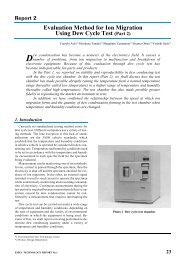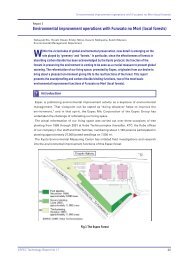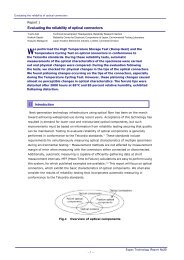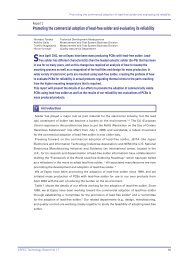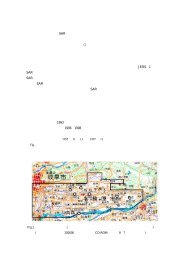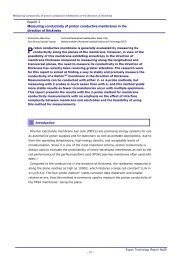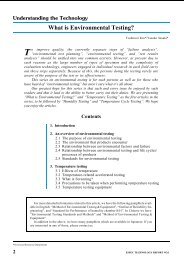Download
Download
Download
You also want an ePaper? Increase the reach of your titles
YUMPU automatically turns print PDFs into web optimized ePapers that Google loves.
5-2 JIS (Japan Industrial Standards)<br />
JIS sets standards for industrial products through<br />
industrial standardization laws aimed at improving<br />
quality. The Ministry of Economy, Trade and Industry<br />
enacts the standards based on investigations by the<br />
Japanese Industrial Standards Committee. As of March<br />
2000, 8,768 JIS standards have been enacted.<br />
To promote international coordination of standards,<br />
many currently enacted JIS standards are direct<br />
translations of ISO and IEC standards. As a result, JIS<br />
standards now are issued using a system of section and<br />
sub-section numbers and supplements that were not used<br />
in earlier JIS standards.<br />
5-2-1 How to read JIS standard ID numbers<br />
The JIS number is composed of an alphabetic character<br />
used as a department symbol, and a classification number.<br />
JIS C 0010- 1993<br />
(1) (2) (3)<br />
(1) The number of the department (C stands for<br />
electronic equipment and electrical machinery.)<br />
(2) The number of the standard (The first two digits on<br />
the left represent the classification. For C, 00 through<br />
09 represent general classification.)<br />
(3) The calendar year of the enactment or revision<br />
5-2-2 Revision<br />
In principle, JIS standards are deliberated every five<br />
years, and can either be “confirmed,” “revised” or<br />
“abolished.” To help you keep abreast of new<br />
developments in this area, the Japanese Standards<br />
Association publishes its official monthly magazine called<br />
The Standardization Journal, and you can also find<br />
information on the Japanese Standards Association<br />
homepage at http://www.jsa.or.jp/.<br />
5-2-3 Environmental test standards<br />
A number of environmental test methods are<br />
established in JIS, but the most common series for the<br />
electrical and electronics field is the C0010 series, almost<br />
all of which has been adopted from the aforementioned<br />
IEC60068 series. (However, the details of some standards<br />
have been modified to conform to the actual circumstances<br />
in Japan.) (Refer to Tables 3 and 4.)<br />
Table 3 JIS C0010 Series (Environmental testing)<br />
No. Title<br />
C0010:93 General and guidance<br />
C0020:95 Cold<br />
C0021:95 Dry heat<br />
C0022:87 Damp heat, steady state<br />
C0023:89 Salt mist<br />
C0024:00 Salt mist, cyclic (sodium, chloride solution)<br />
C0025:88 Change of temperature<br />
C0026:94 Sealing<br />
C0027:88 Damp heat, cyclic (12 +12-hour cycle)<br />
C0028:88 Composite temperature/humidity cyclic test<br />
C0029:89 Low air pressure<br />
C0030:95 Combined cold/low air pressure tests<br />
C0031:95 Combined dry heat/low air pressure tests<br />
C0032:96 Damp heat, steady state, primarily for equipment<br />
C0033:93 Guidance for damp heat tests<br />
C0034:96 Water<br />
C0035:96 Climatic sequence<br />
C0036:97 Vibration, broad-band randam (digital control)<br />
and guidance<br />
C0037:97 Combined dry heat/vibration (sinusoidal) tests<br />
for both heat-dissipating and non-heatdissipating<br />
specimens<br />
C0038:97 Combined cold/vibration (sinusoidal) tests for<br />
both heat-dissipating and non-heat-dissipating<br />
specimens<br />
C0039:97 Guidance to Tests Z/Afc and Z/BFc: Combined<br />
temperature(cold and dry heat) and vibration<br />
(sinusoidal) tests<br />
C0040:99 Vibration (sinusoidal)<br />
C0041:95 Shock<br />
C0042:95 Bump<br />
C0043:95 Drop and topple, primarily for equipment-type<br />
specimens<br />
C0044:95 Free fall (Procedure 1)<br />
C0045:93 Acceleration, steady state<br />
C0046:93 Impact, spring hammer<br />
C0047:95 Mounting of components, equipment and other<br />
articles for dynamic tests including shock (Ea),<br />
bump (Ed), vibration (Fc and Fd) and steadystate<br />
acceleration (Ga) and guidance<br />
C0048:99 Flowing mixed gas corrosion test<br />
C0050:96 Soldering<br />
C0051:94 Robustness of terminations and integral<br />
mounting devices<br />
C0052:95 Immersion in cleaning solvents<br />
C0053:96 Solderability testing by the wetting balance<br />
method<br />
C0054:94 Solderability, resistance to dissolution of<br />
metallization and to soldering heat of surface<br />
mounting devices (SMD)<br />
C0055:00 Guidance. Seismic test method for equipments<br />
C0061:00 Fire hazard testing - Needle-flame test<br />
C0062:87 Fire hazard testing - bad-connection test with<br />
heaters<br />
(Cont.)<br />
ESPEC TECHNOLOGY REPORT No. 12 5



